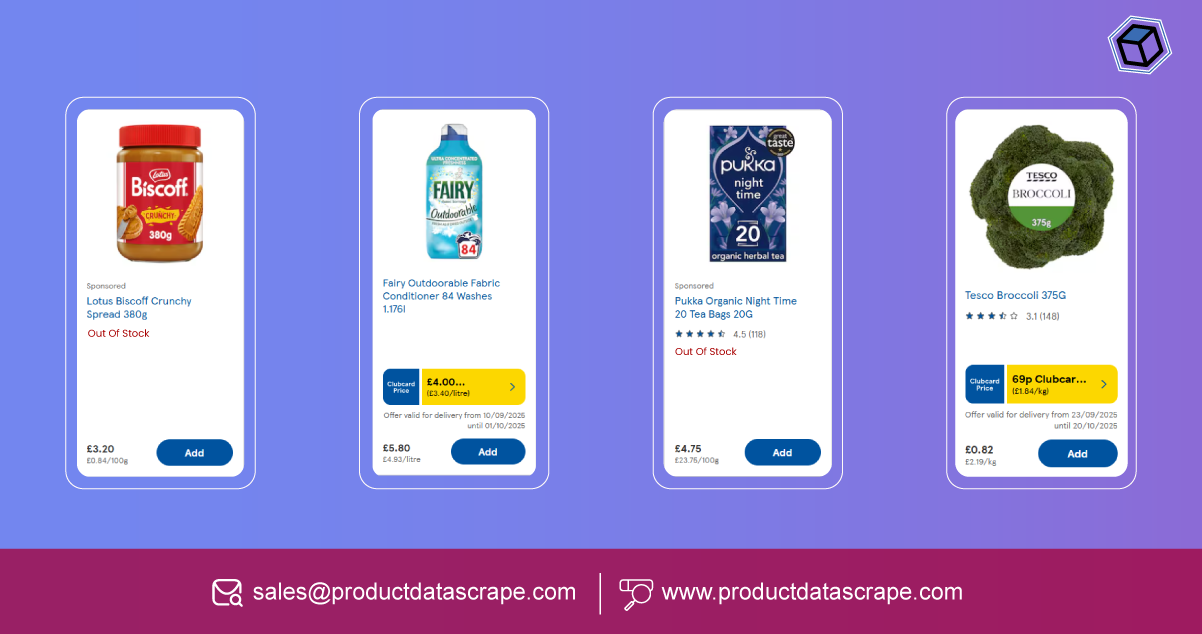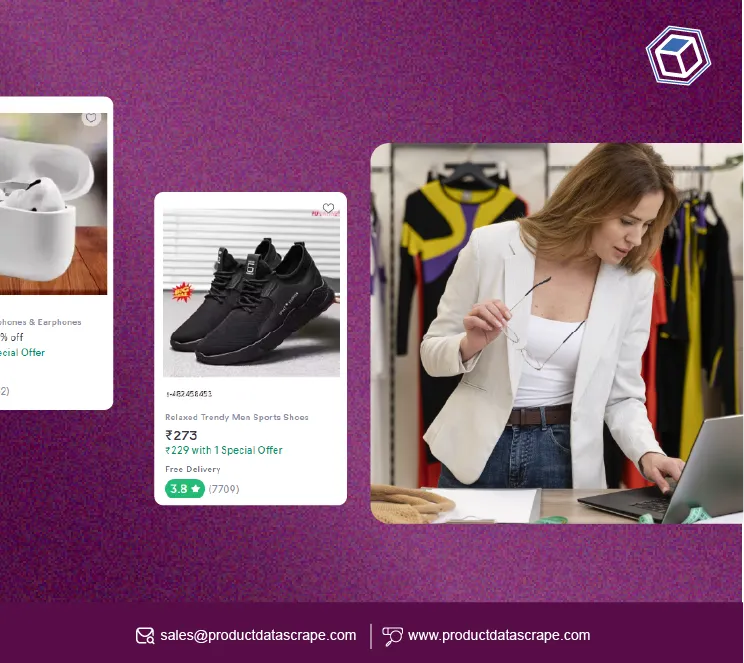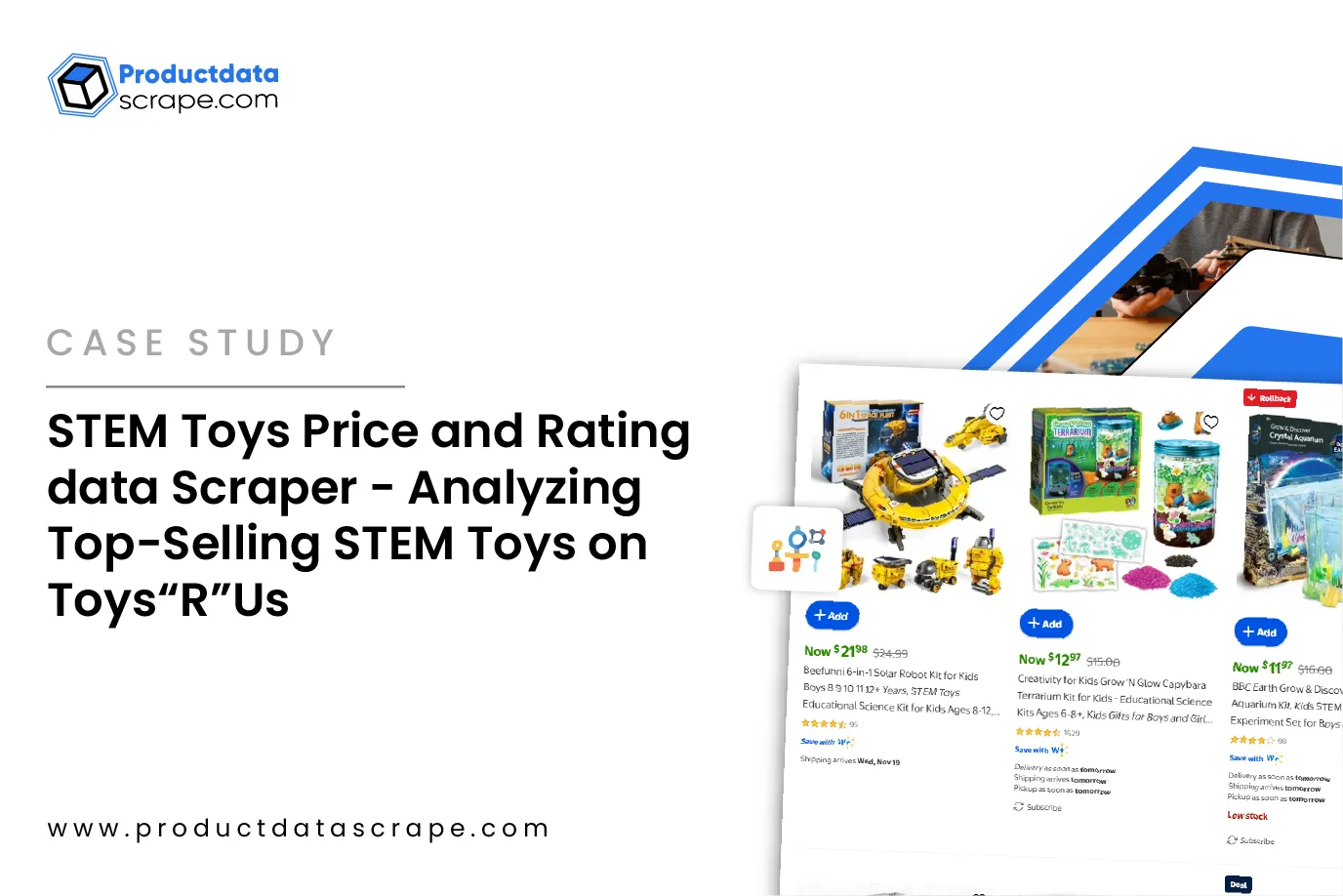
Introduction
In today’s competitive retail environment, understanding product availability at the store level
is crucial for businesses to maintain customer satisfaction and optimize inventory. By using the
Extract Tesco Store-Level Stock Data approach, retailers, e-commerce platforms, and market
analysts can gain real-time insights into Tesco’s product inventory across stores. These
insights help companies track stock levels, monitor trends, and make informed replenishment
decisions.
Tesco, one of the UK’s largest grocery chains, operates thousands of stores with varying stock
availability. Tracking store-level inventory manually is time-consuming and prone to errors. By
leveraging tools like Tesco product stock availability scraper and Scrape Store-level Tesco
stock monitoring, businesses can automate data collection and get accurate, actionable
information.
From 2020 to 2025, grocery trends have shifted dramatically due to seasonal demand, promotions,
and market changes. By analyzing historical data along with real-time stock information using
Real-time Tesco stock scraping tool, retailers can identify high-demand items, forecast
shortages, and ensure optimal inventory levels.
This blog will explore six key strategies and solutions that demonstrate how Extract Tesco
Store-Level Stock Data can transform your retail operations, improve efficiency, and drive
profitability.
Scrape Tesco Grocery Availability by Store
The foundation of effective inventory management lies in understanding Tesco
Grocery availability by store. By using a Tesco product stock availability scraper, businesses
can monitor which products are available at specific locations, helping avoid stockouts or
overstocking.
Historical data from 2020 to 2025 shows clear patterns in grocery demand. For
instance, fresh produce and dairy items often experience high turnover during weekdays, while
packaged goods and snacks peak over weekends. With a Grocery store stock availability extractor,
companies can collect this data systematically, creating actionable dashboards that visualize
stock levels by store, product category, and region.
Scraping store-level data also enables businesses to identify performance
variations among stores. For example, one store may consistently run out of popular cereal
brands while another maintains steady stock. Understanding these differences helps optimize
replenishment strategies, ensuring customers find products when they visit any Tesco store.
Furthermore, integrating this data with tools like Tesco Grocery Store Dataset
provides additional insights into historical inventory trends, seasonal spikes, and regional
preferences. This allows retailers to adjust procurement schedules, reduce waste, and improve
overall operational efficiency.
By leveraging Extract Tesco Store-Level Stock Data, businesses can automate
data collection, track product availability in real time, and maintain competitive advantage in
the grocery sector.
Tesco Store-Level Inventory Monitoring API
Efficient inventory management requires real-time visibility into stock levels
across multiple stores. Using Tesco store-wise inventory monitoring API, businesses can
seamlessly access updated product data and make informed decisions.
From 2020 to 2025, data analysis shows significant shifts in grocery
consumption patterns. For example, the demand for ready-to-eat meals increased by 25% in urban
stores, while packaged staples like rice and flour saw steady demand across all locations. A
Real-time Tesco stock scraping tool can extract these insights, helping retailers adjust
inventory dynamically and avoid stockouts during peak demand periods.
API-driven monitoring allows businesses to integrate store-level stock data
directly into internal inventory systems, supporting automated replenishment workflows. This
reduces manual effort, minimizes errors, and ensures consistency across multiple locations. For
instance, alerts can be triggered when stock levels fall below a predefined threshold, enabling
timely restocking.
Combining real-time data with historical trends allows predictive forecasting.
Retailers can anticipate product shortages or surges in demand, optimizing procurement and
logistics. Leveraging a grocery inventory data scraping service enhances accuracy and
scalability, making it possible to monitor thousands of SKUs across hundreds of Tesco stores
simultaneously.
Ultimately, a Tesco store-wise inventory monitoring API provides a robust
foundation for operational efficiency, cost savings, and improved customer satisfaction by
maintaining optimal product availability across stores.
Monitor stock efficiently—use Tesco Store-Level Inventory Monitoring API
to track inventory, optimize replenishment, and ensure products are
always available!
Contact Us Today!
Scrape Store-Level Tesco Stock Monitoring
Maintaining consistent product availability requires ongoing tracking of stock
across multiple locations. Using Scrape Store-level Tesco stock monitoring, businesses can
continuously track inventory changes, analyze trends, and respond proactively to fluctuations.
Historical data from 2020–2025 highlights seasonal spikes in grocery purchases.
For instance, beverages and confectionery see a 15–20% increase in demand during holidays, while
staples like milk and bread remain steady year-round. By monitoring these trends, retailers can
plan stock allocation efficiently.
A Tesco product stock availability scraper collects data such as product name,
quantity, and pricing across stores, enabling a centralized view of stock levels. This
facilitates better decision-making, helping retailers determine which stores require immediate
replenishment and which have excess inventory.
Additionally, monitoring data alongside Web Scraping Tesco Groceries Data
allows businesses to detect inconsistencies between online and in-store availability. This
ensures customers can rely on accurate stock information when shopping online, improving
customer experience and loyalty.
Using automated store-level monitoring, businesses reduce manual checks, save
time, and make data-driven decisions. This approach also supports forecasting, pricing strategy,
and promotional planning. By implementing Scrape Store-level Tesco stock monitoring, companies
can ensure efficient inventory management across all stores.
Tesco Store-Level Review Data Extractor
Customer feedback is critical for understanding product performance at the
store level. A Tesco store-level review data extractor allows businesses to gather review data
for specific products, providing insights into consumer preferences and satisfaction.
From 2020 to 2025, analysis shows that stores with consistently high stock
levels tend to receive more positive feedback, while stockouts correlate with negative reviews.
By combining review data with Extract Tesco Store-Level Stock Data, retailers can correlate
inventory availability with customer satisfaction.
This approach helps businesses identify popular products, seasonal favorites,
and potential inventory gaps. For instance, a spike in positive reviews for ready-to-eat meals
may indicate increasing demand, prompting adjustments in stock allocation.
Integrating review insights with Product Price Data Scraping Services allows
for comprehensive analysis, comparing price points with customer sentiment. This helps optimize
pricing, product positioning, and promotions across stores.
Using a review data extractor, companies gain a holistic view of product
performance, ensuring informed decisions that enhance customer experience and sales performance.
Extract Grocery & Gourmet Food Data
Grocery retailers must track broader category-level trends to optimize
inventory and product offerings. Using Extract Grocery & Gourmet Food Data , businesses can
analyze stock patterns, seasonal trends, and category performance across Tesco stores.
Historical data from 2020–2025 shows that premium gourmet products experienced
a 12–15% annual growth in urban stores, while staple groceries maintained steady demand. This
insight helps retailers plan assortments and promotional strategies effectively.
By integrating Tesco Grocery Data Scraping API and Tesco Grocery Store Dataset,
businesses can automate data collection for thousands of products, ensuring accurate and
up-to-date insights. Combining this with store-level stock monitoring enables retailers to align
inventory levels with demand forecasts, reducing waste and improving profitability.
Extracting category-level intelligence also supports marketing campaigns,
assortment planning, and strategic sourcing decisions. Companies can identify emerging trends,
optimize product placement, and respond to shifting consumer preferences.
Unlock market insights—extract grocery & gourmet food data to track
trends, optimize inventory, and boost sales effectively today!
Contact Us Today!
Web Scraping Tesco Groceries Data
Automating data collection using Web Scraping Tesco Groceries Data enables
businesses to access store-level inventory, pricing, and promotional information efficiently.
Real-time scraping ensures timely updates, reducing errors associated with manual tracking.
From 2020–2025, analysis of store-level data shows significant fluctuations
during festive periods, promotional events, and seasonal trends. Using a Real-time Tesco stock
scraping tool, companies can adjust inventory, plan logistics, and respond to demand spikes
effectively.
Integrating this data with Tesco Grocery Store Dataset and Grocery store stock
availability extractor provides a comprehensive view of product availability. Businesses can
forecast demand, optimize replenishment, and ensure consistent stock across all stores.
Automated web scraping streamlines operations, enhances decision-making, and
provides actionable insights for retailers, e-commerce platforms, and analysts. By leveraging
this approach, businesses maintain competitive advantage while ensuring customers find products
in stock when needed.
Why Choose Product Data Scrape?
- Real-Time Data: Monitor product availability as it
changes.
- Comprehensive Coverage: Track thousands of SKUs across
multiple stores.
- Custom Datasets: Tailored to your business needs,
including grocery and gourmet products.
- Automation: Reduce manual effort while ensuring accuracy.
- Actionable Insights: Data supports inventory
optimization, pricing strategy, and promotions.
By partnering with Product Data Scrape, retailers gain a competitive edge,
improving operational efficiency and customer satisfaction.
Conclusion
In a competitive retail market, knowing what products are available, where, and
when is critical. The Extract Tesco Store-Level Stock Data approach provides businesses with
actionable insights to optimize inventory, forecast demand, and enhance customer satisfaction.
From tracking daily stock levels to analyzing seasonal trends and customer
reviews, using a Tesco product stock availability scraper ensures accurate, real-time data.
Businesses can streamline operations, reduce stockouts, and make data-driven decisions for
maximum profitability.
Don’t let stockouts or inaccurate data impact your business. Contact Product
Data Scrape today to extract Tesco store-level stock data and gain actionable insights for
smarter retail decisions!















.webp)
-01.webp)

.webp)
.webp)
.webp)